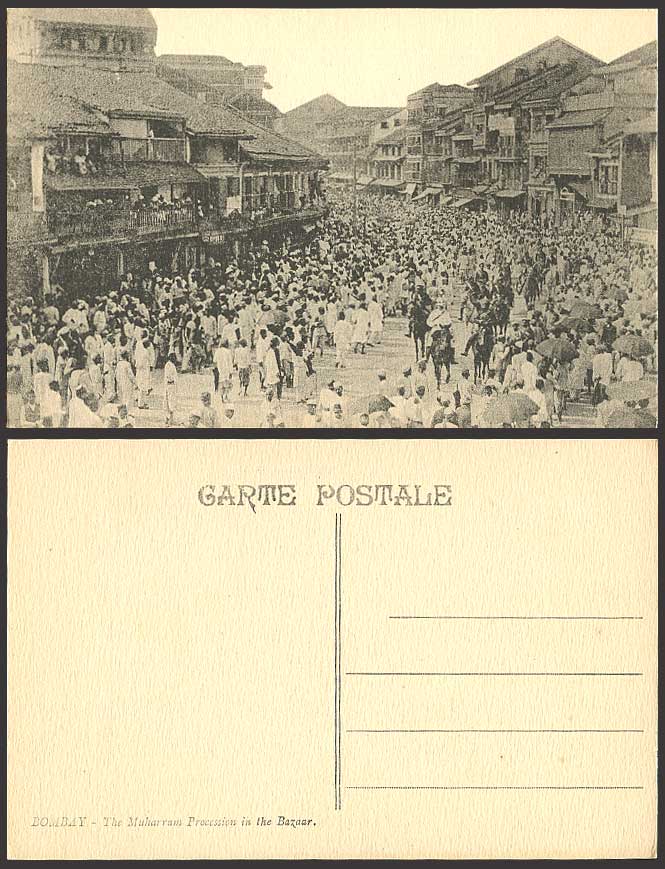
View of Muharram Procession in Bombay(Mumbai)on Postcard
Dr.Mazhar Naqvi
Dr.Mazhar Naqvi
Among Indian festivals, the British
looked at Muharram with fear and fascination both. The textual descriptions of festival
Muharram in colonial India project it as an occasion that the authorities
dreaded since Muharram Riot of 1779.But the images of Muharram processions on
postcards present it as the most spectacular event of the British raj. In 1779,
Muslims had went on rampage after a British officer exhibited a sort of
discourtesy to a tazia procession. The crowd also pelted stones at the Supreme Court
building. The incident was duly investigated and since then British found the festival
capable of uprooting their regime and exercised fist control and constant
monitoring during its observance.
Their approach remained somewhat same till 1870.When they found their regime well-established after the ‘Mutiny’ of 1857,the British didn’t become complacent so far as the administrative control on Muharram observation was concerned. But they allowed the grandeur, pomp and show associated with Muharram processions to flourish on postcards.
A number of postcards carried images of Muharram processions with tazias and Tabuts between 1870-1915.Marcopolo and company printed in Germany a postcard depicting Muharram in Calcutta with the title ‘Calcutta, Mohurram Festival on Maidan’ . The image shows a large group of people gathered around a body of water. It also depicts a number of horse-drawn carriages in the foreground, and an orderly row of white tents in the background. As the picture was taken from a distance, all the visual characteristics of muharram appear to be missing from the image but a careful study of the photograph reveals two ‘Tabuts’ standing at the water’s edge, to the left of a leafless tree.
Two postcards of the Bombay Muharram are also worth mentioning and comparing. The first, published by the Phototype Company and posted in 1905, is remarkable for the absence of any visual cues of Muharram. Taken in Pydhownie Street in Bombay, the photograph is taken at closer range than in the Calcutta postcard and therefore appears more crowded. In the middle of the road a more open space has been created for several policemen who patrol on horseback, at least one of whom is British.

British
officers frequently accompanied processions, as John Campbell Oman described in
1902: ‘behind [the procession] rode the embodiment, for the nonce, of the
British raj, a solitary Englishman, with a resolute but bored expression on his
face—the Assistant Superintendent of Police’. The British policeman as the
embodiment of the Raj, and therefore of control, again connects Muharram with
potential disorder:The
other post card carries coloured photograph of ‘Taboot Procession Bombay’ It also shows the
Pydhownie street, but presents a different impression of Muharram. The photograph
has been taken from a slightly higher standpoint and the swaying movement of
the ‘Tabuts’ be experienced. The image exhibits the streets, houses and even
their roofs packed with people. It presents Muharram
purely as a solemn festival in contrast to British efforts to portray it as an occasion to spark off
violence in Bombay by the end of 19th century and early 20th
century.Another noteworthy postcard on Muharram was published
in Gwalior’( a princely state under
British protection).The picture is taken from a roof and shows at least two Tabuts
in a street full of people. Despite the photographer’s proximity to the event,
the height of his viewpoint separates the viewer from the crowds milling below,
creating a sense of security and control. It was published by an Indian, S.
Mahadeo of Belgaum and printed in Saxony.These postcards of immense historical significance as they depict how the perception of British remained or changed with regard to Muharram observance in India.
(The article is based on inputs
taken from the scholarly work of Rianne Siebenga- Universiteit
Utrecht.Photo Courtesy Google Image)
No comments:
Post a Comment